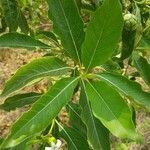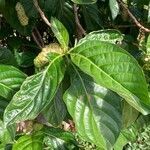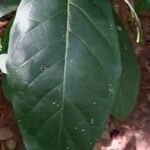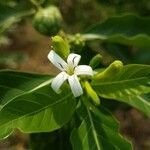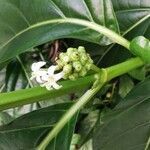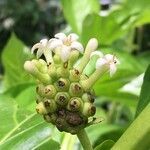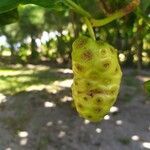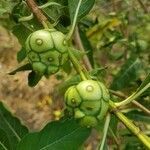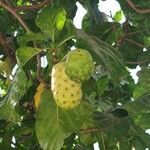| Therapeutic use
|
Analgesics (bark), Anti-bacterial agents (bark), Antipyretics (bark), Asthma (bark), Cholera (bark), Diarrhea (bark), Furunculosis (bark), Gout (bark), Hematologic diseases (bark), Jaundice (bark), Skin diseases (bark), Smallpox (bark), Urologic diseases (bark), Wound healing (bark), Wounds and injuries (bark), Eye diseases (flower), Gout (flower), Hematologic diseases (flower), Jaundice (flower), Wounds and injuries (flower), Dermatological Aid (fruit), Orthopedic Aid (fruit), Stomach diseases (fruit), Analgesics (fruit), Anti-bacterial agents (fruit), Anticonvulsants (fruit), Antifungal agents (fruit), Antineoplastic agents (fruit), Antioxidants (fruit), Antipyretics (fruit), Antitussive agents (fruit), Antiviral agents (fruit), Anxiety disorders (fruit), Asthma (fruit), Carbuncle (fruit), Cataract (fruit), Common cold (fruit), Constipation (fruit), Dental caries (fruit), Diabetes mellitus (fruit), Dysentery (fruit), Fractures, bone (fruit), Furunculosis (fruit), Hematologic diseases (fruit), Hyperlipidemias (fruit), Hypnotics and sedatives (fruit), Immunomodulation (fruit), Laxatives (fruit), Leukorrhea (fruit), Liver diseases (fruit), Memory disorders (fruit), Menstruation-inducing agents (fruit), Neurotic disorders (fruit), Periodontal diseases (fruit), Pharyngitis (fruit), Anti-poisoning (fruit), General tonic for rejuvenation (fruit), Stomach ulcer (fruit), Ulcer (fruit), Wound healing (fruit), Uricosuric agents (fruit), Deobstruent (fruit), Unspecified (leaf), Analgesics (leaf), Dizziness (leaf), Wound healing (leaf), Anthelmintics (leaf), Anti-bacterial agents (leaf), Antifungal agents (leaf), Anti-inflammatory agents (leaf), Antioxidants (leaf), Antipyretics (leaf), Antiviral agents (leaf), Arthralgia (leaf), Cathartics (leaf), Common cold (leaf), Cough (leaf), Diarrhea, infantile (leaf), Digestive system diseases (leaf), Dysentery (leaf), Fever (leaf), Fractures, bone (leaf), Gout (leaf), Hematologic diseases (leaf), Hemorrhage (leaf), Hyperlipidemias (leaf), Insecticides (leaf), Jaundice (leaf), Menstruation-inducing agents (leaf), Parasympatholytics (leaf), Periodontal diseases (leaf), Pharyngitis (leaf), General tonic for rejuvenation (leaf), Smallpox (leaf), Sprains and strains (leaf), Thrombosis (leaf), Ulcer (leaf), Wounds and injuries (leaf), Deobstruent (leaf), Antipyretics (root), Antitussive agents (root), Diarrhea (root), Jaundice (root), Anti-bacterial agents (root), Antifungal agents (root), Anti-inflammatory agents (root), Antineoplastic agents (root), Aphrodisiacs (root), Astringents (root), Blood pressure regulation (root), Cathartics (root), Fractures, bone (root), Gout (root), HIV infections (root), Hypnotics and sedatives (root), Pain (root), Parasympatholytics (root), Skin diseases (root), Ulcer (root), Urination disorders (root), Wounds and injuries (seed), Anti-bacterial agents (stem), Ague (unspecified), Anodyne (unspecified), Arthritis (unspecified), Beriberi (unspecified), Bite(Bug) (unspecified), Boil (unspecified), Chest (unspecified), Colic (unspecified), Collyrium (unspecified), Convulsion (unspecified), Cough (unspecified), Diabetes (unspecified), Diarrhea (unspecified), Diuretic (unspecified), Dysuria (unspecified), Elephantiasis (unspecified), Emmenagogue (unspecified), Eye (unspecified), Fever (unspecified), Filariasis (unspecified), Gingivitis (unspecified), Gout (unspecified), Inflammation (unspecified), Jaundice (unspecified), Laxative (unspecified), Leucorrhea (unspecified), Leukorrhea (unspecified), Medicine (unspecified), Purgative (unspecified), Rheumatism (unspecified), Sapraemia (unspecified), Sedative (unspecified), Shampoo (unspecified), Splenomegaly (unspecified), Swelling (unspecified), Tetanus (unspecified), Throat (unspecified), Tonic (unspecified), Toothache (unspecified), Tuberculosis (unspecified), Wound (unspecified), Abscess (unspecified), Abdomen (unspecified), Analgesic (unspecified), Conjunctivitis (unspecified), Nausea (unspecified), Smallpox (unspecified), Sty (unspecified), Headache (unspecified), Breast (unspecified), Cathartic (unspecified), Dysentery (unspecified), Kidney (unspecified), Myalgia (unspecified), Hepatosis (unspecified), Sore (unspecified), Anasarca (unspecified), Baldness (unspecified), Dropsy (unspecified), Rinderpest (unspecified), Cholera (unspecified), Parturition (unspecified), Splenosis (unspecified), Piles (unspecified), Parasympatholytics (unspecified), Anti-bacterial agents (unspecified), Antifungal agents (unspecified), Anti-inflammatory agents (unspecified), Antioxidants (unspecified), Pain (unspecified), Periodontal diseases (unspecified), Pharyngitis (unspecified), Diuretics (whole plant), Anti-infective agents (whole plant)
|
